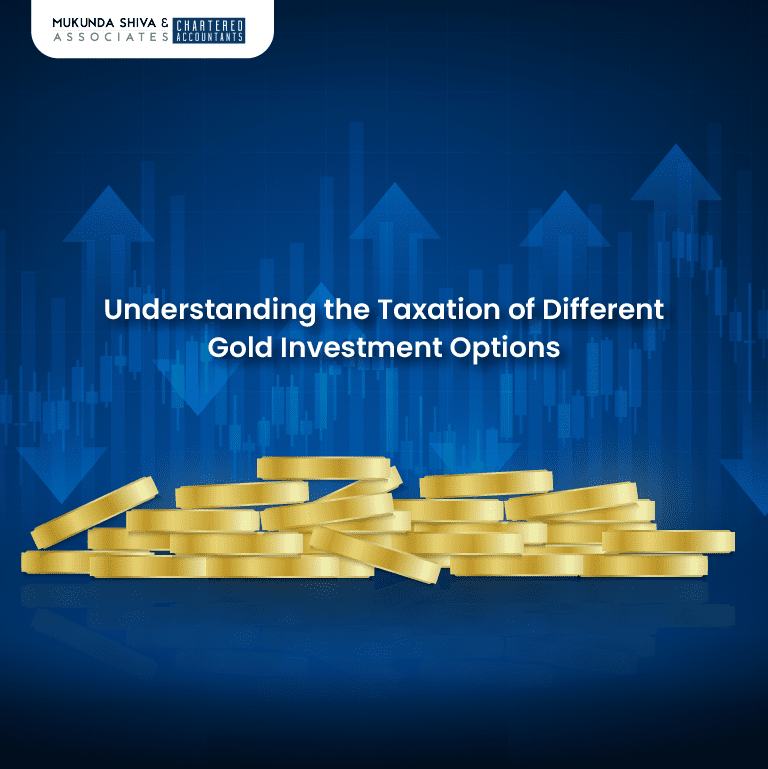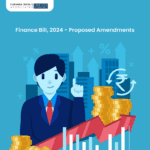
Understanding the Taxation of Different Gold Investment Options
Summary of Amendments – DIRECT TAXATION

Safeguard your Gold & Manage Taxation
Have you ever thought storing gold at home is secure and storing gold in a bank locker is cost effective?
Here is the workaround for all your worries!
As we all know, Gold holds a Significant place in Indian Culture & has remained one of India’s most preferred modes of investment for a long time. With a plethora of options available in today’s world, gold investment in India extends beyond acquiring gold solely in its physical state.
Here are some new forms of gold investment in India which are equivalent to buying physical gold without any hassles of going to a store.
Gold ETF:
Gold ETF is an exchange-traded fund that serves as a substitute for physical gold.
Gold ETFs purchase 99.5% pure gold from banks approved by the Reserve Bank of India (RBI). A single unit of gold ETF is equivalent to one gram of gold.
Gold Mutual Fund:
Almost identical to gold ETFs, Gold Mutual Fund differs slightly based on content. Unlike gold ETFs, these gold funds are sold and redeemed by the mutual fund AMC at NAV-linked prices. The fund announces the NAV on a daily basis, which is based on the market value of gold, adjusted for the TER (total expense ratio).
Digital Gold:
Digital gold in India is offered by MMTC-PAMP, Augment, and Safe Gold. You can also buy it from platforms such as mobile e-wallets, broking firms, and financial institutions. The basic difference is in the mode of purchase – one can buy digital gold online and store it securely in vaults by the insurer. Regulatory bodies like RBI or SEBI lack jurisdiction over this investment avenue.
Sovereign Gold Bonds:
Sovereign gold bonds are RBI-issued government bonds representing grams of physical gold. These are sold through banks, post offices, Stock Holding Corporation of India, and authorized stock exchanges and are offered in a limited number of tranches annually.
As we are discussing on safeguarding of our gold, it’s also important to understand regarding Taxation on the same...

Capital gains are considered short-term capital gains if the income arises from the sale of stocks that were on hold for less than 3 years. Likewise, capital gains are considered long-term capital gains when the holding period is greater than 3 years
| Gold Investment Options | Taxation | |
| Short Term Capital Gain | Long Term Capital Gain | |
| Physical Gold | Taxable as per the individual's income tax slab | Taxable @ 20% along with the Indexation benefits & Surcharge if applicable. |
| Gold ETF | ||
| Gold Mutual Funds | ||
| Digital Gold | Taxable @ 20% with indexation benefits and 10% without. |
|
| Sovereign Gold Bonds(Refer Note) | ||
Note: However, it’s exempt if the bonds are held till maturity — an eight-year period. Also, LTCG applies to individuals and not HUFs and Trusts.
Let’s dive deeper into SGB’s:
Since SGBs are classified as securities and are digital assets, charges or GST do not apply. However, GST applies to the Securities Transaction Tax (STT) and brokerage, amounting to a maximum of 0.75% of the purchase value, resulting in minimal GST liability for SGBs.
While TDS is not applicable for SGBs, income tax is levied on the interest earned, which offers a 2.5% per annum interest rate. This is added to the income and taxed according to the applicable tax slab. This may represent an additional tax, but SGBs provide interest, unlike physical gold.
Let's look at the factors to take into account while making gold investments:
- GST 3% will be charged at the moment the physical or digital gold is purchased; this will be an additional expense that cannot be recovered later.
- Investing in physical gold, especially in the form of jewelry, requires you to pay a fee i.e., making Charges, which could be between 10 and 20 percent.
- Investing in gold mutual funds or gold exchange-traded funds (ETFs) can yield dividend income.
- Investors can obtain taxable Interest Income by investing in SGBs.
Can Gold ETF be redeemed into Physical gold and vice versa?
AMC facilitates to the Authorized Participants / Large Investors to purchase or
sell Gold on their behalf for the purpose of creating/redeeming Units in Creation Unit Size.
AMCs permit redemption of Gold ETF Units in the form of physical gold in ‘Creation Unit’ size, if one holds equivalent of 1kg of gold in ETFs, or in multiples thereof.
Taxability for Redemption of Gold ETF to Physical Gold and Vice Versa:
In order to promote the concept of Electronic Gold, Conversion of physical form of gold into EGR and vice versa by a SEBI registered Vault Manager has been excluded from the purview of ‘transfer’ for the purposes of Capital gains. (Sec 47(vii d))
| Transactions | Taxability | Period of Holding (PoH) | Cost of Acquisition (CoA) |
| Conversion of Gold into EGR | Not Taxable | - | - |
| Sale of EGR | Taxable | PoH of Gold + PoH of EGR | CoA of Gold |
| Conversion of EGR into Gold | Not Taxable | - | - |
| Sale of Gold | Taxable | PoH of EGR + PoH of Gold | CoA of EGR in the Hands of Seller |
Example:
Purchase of Physical Gold on 01/01/2024: Rs.15,00,000
Conversion of Gold to EGR on 01/03/2024 by through a SEBI registered Valuer.
Sale of EGR on 01/04/2024: Rs. 17,00,000
Taxability:
Capital Gain will arise when the sale transaction has been made i.e., on 01/04/2024 with COA 15,00,000 & Holding Period should be considered from the Date of Acquisition till the Date of sale i.e., 3 Months. No capital Gains will arise on the date of conversion of Gold to EGR.
1. Procedure for redemption of Gold ETF to Physical Gold:
The procedure by which Authorized Participants / Large Investors can redeem the ETF units in Creation Unit Size is as follows:
- Authorised Participants / Large Investors may make a redemption request to the AMC for redemption of the ETF units in Creation Unit Size on any Business Day in a duly filled redemption form, within the applicable cut‐off timing for NAV applicability.
- By placing the redemption request, the Authorised Participants/Large investors agree to transfer the requisite number of the ETF units in Creation Unit Size to the Scheme’s DP accounts on T+0 business day.
- The request for redemption by Authorised Participants / Large Investors needs to be enclosed with the delivery order used in the depository system duly acknowledged by the DP with whom the Authorized Participants / Large Investors has a depository account stating the number of the units transferred to the Scheme’s DP account.
- After successful verification of the redemption request, the AMC will instruct the Custodian to transfer the Portfolio Deposit of Gold to the custody account of Authorized Participant/Large Investors and remit/collect the Cash Component after adjusting transaction handling charges, other applicable charges and the difference between the applicable NAV and closing price of gold.
- The expenses associated with taking the delivery of Gold will have to be borne by Authorised Participants/Large Investors.
- The delivery of gold to Authorised Participants / Large Investors will be made at the location of the Custodian within the jurisdiction of Mumbai.
The redemption price for redemption of units in Creation Unit Size will be based on the applicable NAV on the redemption request date subject to cut‐off timing limits.
2. Procedure for conversion of Physical Gold into Gold ETF:
- Authorized Participants may submit an application for purchase of the ETF units in Creation Unit Size to the AMC on any Business Day, within the applicable cut‐off timing for NAV applicability.
- By submitting the application, the Authorized Participants agree to transfer (deposit) the Portfolio Deposit (i.e. physical gold) and the Cash Component, if any in the Scheme’s account. The day on which the application is submitted (within the applicable cut-off timing) is referred to as the ‘T’ day.
- Authorized Participants are required to transfer (deposit) the Portfolio Deposit (i.e. gold) to the Custodian latest by T+2-day basis, while the balance Cash Component, if any has to be paid to the AMC only by means of payment instruction of Real Time Gross Settlement (RTGS) /National Electronic Funds Transfer (NEFT) or Funds Transfer Letter/ Transfer Cheque of a bank where the Scheme has a collection account. The Cash Component has to be paid to the AMC latest by T + 1-day basis.
- The total amount of gold and equivalent Cash Component, if any required for creation of units in Creation Unit Size will be based on the pro rata amount of the NAV of the Scheme represented by the Creation Units (i.e. 1,000 units) being created determined on the day the request to create is placed by the Authorized Participants.
- As per the agreement with Custodian for gold, Custodian will accept gold only if the gold is in compliance with the Good Delivery norms as specified by LBMA which are as under:
(a) Original Assay Certificate;
(b) Bar list from the refiner;
(c) relevant shipping documents (airway bill and customs invoice) establishing that the gold has been shipped directly from a Good London Refiner using an accredited international shipping company on a door-to-door basis through one of the accredited agencies; and
(d) such other documents that the Custodian may require from time to time so as to adequately indicate the purity of the Gold deposited with it. Further, such portfolio deposit has to be delivered at the location of the Custodian in Mumbai and the incidental expenses, if any and responsibility for transporting the gold to the Custodian shall be of the Authorized Participant/Large Investor. The Custodian will ensure that all Gold deposited with it is accompanied by the above documents and that the gold bars indicate that the fineness is 995 or above.
- On having credited the Scheme’s account with the gold deposits in the form, the custodian will confirm to the AMC of vaulting of gold and in turn AMC instructs the registrar the total number of units to be created and upon realization of the Cash Component, the creation of units will be at the NAV of the scheme on T Day (i.e. the date on which application was made by Authorized Participants within the applicable cut‐off timing).
- The Registrar & Transfer Agent will then allocate the units to the demat account of the Authorized Participant.
Recent Posts
- Finance Bill, 2024 – Indirect Taxation July 23, 2024
- Finance Bill, 2024 – Direct Taxation July 23, 2024
- Understanding the Taxation of Different Gold Investment Options May 22, 2024
- Finance Bill, 2024 – Proposed Amendments February 1, 2024
- Finance Act, 2023 GST related Amendments August 9, 2023


